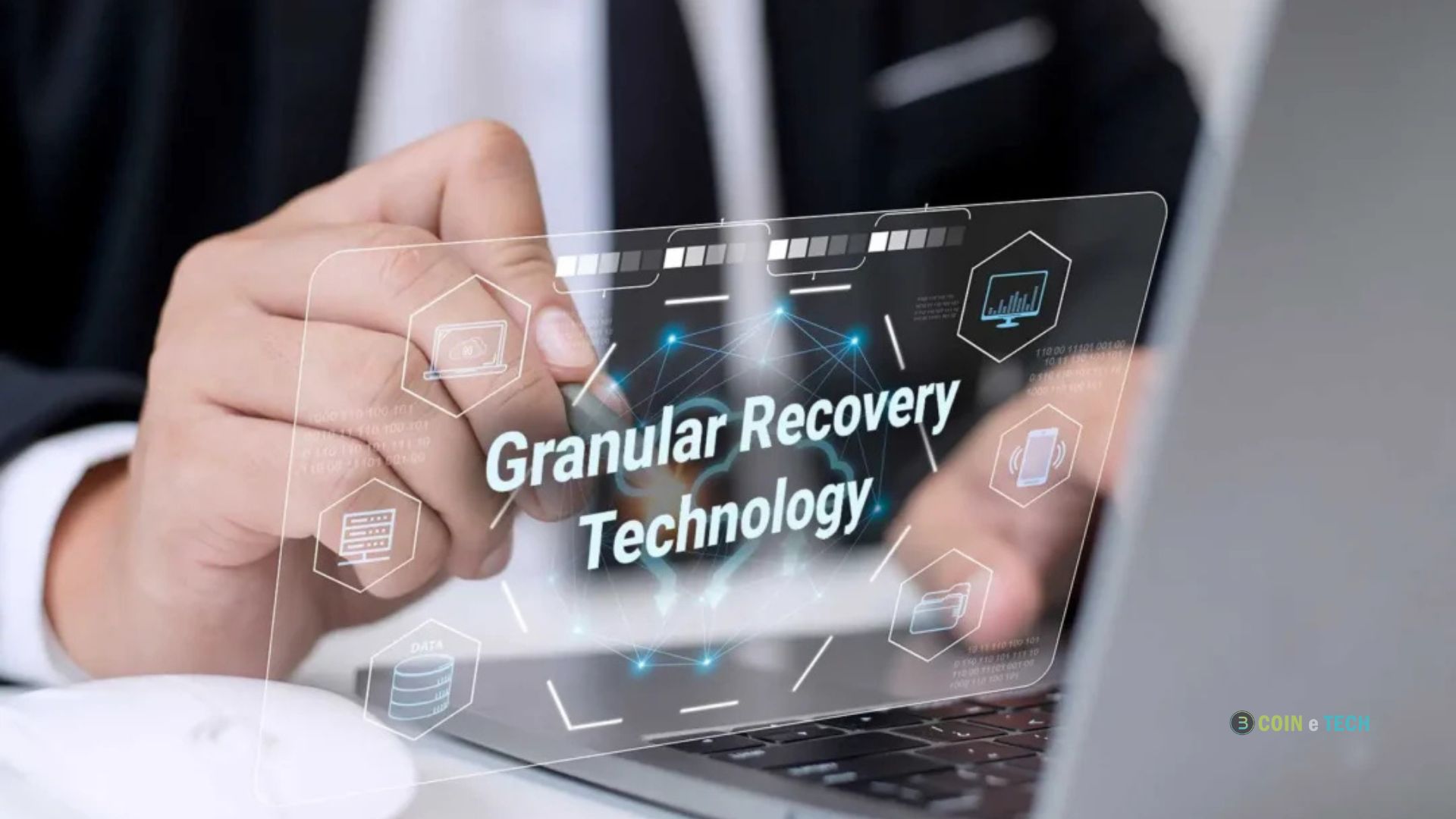Businesses, governments, and individuals alike rely heavily on data in this digital age. The necessity for effective backup and recovery solutions is rising in tandem with the exponential growth of data usage. The capacity to recover important data following a catastrophe, corruption, or inadvertent. Loss is inevitable, whether it’s financial, consumer, or sensitive data. Granular recovery technology allows firms to restore individual files rather than databases or systems. Granular recovery technology, its functioning, benefits, and potential usage in the data-driven society will be discussed in this essay.
What Is Granular Recovery Technology?
Granular recovery technology is a level of advanced data recovery that lets users retrieve only certain parts of data from backups instead of recovering the whole system or database. You can choose which files, folders, mailboxes, emails, databases, or even application-level data to rescue. Since only a small quantity of data needs to be restored, data restoration becomes extremely rapid and precise.
Granular recovery is very useful in current business settings with lots of data, since restoring whole databases can take a long time and a lot of resources. Focusing on only the data that needs to be recovered helps businesses keep operations running smoothly, reduce downtime, and avoid overwriting data that doesn’t need to be overwritten.
How Granular Recovery Technology Works
The main idea behind partial recovery is that it can separate certain pieces of data in a backup. Full copies of files, databases, or programs are usually stored by traditional backup systems. Granular recovery options, on the other hand, let users break down backups into smaller, easier-to-handle pieces. This way, users can find and recover just the lost, damaged, or deleted data.

In simpler terms, here’s how the process works:
- Data Backup Creation: The first step is creating a backup. Granular recovery systems typically work with backups created at the file, application, or database level. These systems capture snapshots of the entire dataset, but they store metadata that allows for individual items to be easily identified and accessed.
- Data Identification: Once a backup is created, granular recovery systems index the data and maintain metadata about the various components within the backup. This indexing process ensures that individual files, emails, or database entries can be located quickly, making it easier to target specific data during recovery.
- Recovery Selection: In the event of data loss, a user can specify which exact data they want to recover. Instead of restoring an entire backup, the user can search for the file, folder, or database entry they need and initiate a targeted recovery process.
- Data Restoration: Once the specific data has been identified, the system restores only that portion of data, allowing the rest of the system or database to remain unaffected. This selective restoration process greatly speeds up recovery times and reduces the resources needed to recover critical data.
Microsoft Exchange, SQL Server, virtual machines, and file servers are just a few of the many types of systems that can benefit from granular recovery.
Benefits of Granular Recovery Technology
Granular recovery technology offers a range of benefits, particularly for organizations that rely on large, complex datasets. Here are some of the most significant advantages:
Faster Recovery Times
One great thing about granular recovery technology is that it can cut recovery times by a huge amount. Using old-fashioned ways to get back lost data, fixing a whole system or database can take hours or even days, based on how big the data is. Granular recovery gets rid of the need to fix everything, so users can quickly get back only the data they need. This quick restoration process is very important for keeping businesses running and avoiding pricey disruptions.
Reduced Storage Requirements
Granular recovery lets you restore single pieces of data instead of whole files, which means that you usually don’t need as much storage space. By only backing up changes or certain items, businesses can avoid keeping many full copies of big databases, which saves them money on storage and infrastructure management. Furthermore, this decrease in storage needs may also make cloud or on-premise storage options work better.
Lower Costs
Lower costs are directly linked to faster healing times and less storage space needs. Businesses don’t have to spend much money on storage space or hardware to do regular full-system backups when they use granular recovery. Selective recovery saves time, meaning less work is needed to handle the backup and recovery process, lowering operational costs.
Minimal Data Overwrite Risks
Data that hasn’t been touched could be mistakenly replaced or damaged while restoring a whole system or database using standard procedures. This is called data overwriting. Granular recovery mitigates this risk by selectively restoring corrupted data while preserving intact data. This approach prevents unnecessary overwrites and maintains a stable data environment.
Improved Disaster Recovery and Business Continuity
Granular recovery is an important part of planning for disaster recovery. Businesses can quickly get back to important data after a disaster or cyberattack by allowing fast and focused recovery. With this much speed and accuracy, businesses can keep their operations running, keep their service-level agreements (SLAs), and lessen the effects of downtime on customers and other important people.
Granular recovery technology has changed to work with virtual environments and cloud infrastructure as more companies use them. Virtual machine (VM) settings like VMware and Microsoft Hyper-V often have granular recovery built in. This feature lets users get back specific files. Folders, or even VM-level data from backups or snapshots without having to restore the whole virtual machine. Because it is so flexible, granular recovery works great for current cloud-based systems.
Use Cases for Granular Recovery Technology
Granular recovery technology is a powerful tool that can be applied in various industries and scenarios. Some common use cases include:

Email Recovery
Email is an important way for most companies to communicate. Granular recovery technology lets businesses restore specific emails or whole mailboxes without having to restore the whole email system. This is especially helpful for companies. They use Microsoft Exchange or Office 365 to keep track of individual emails or files for compliance or auditing reasons.
Database Recovery
Many important data, like customer information and business records, are often stored in databases. With granular recovery, companies can regain certain database records, tables, or schemas without restoring the whole database. This selected recovery method lowers the chance of downtime and ensures that the business can keep running smoothly.
Virtual Machine Recovery
As businesses depend more on virtualized settings, it’s important to be able to get back specific virtual machine parts. Administrators can restore specific files or directories within a VM without having to restore the whole machine with granular recovery options that work with platforms like VMware or Hyper-V.
Compliance and Data Audits
Many fields, like finance and healthcare, have strict rules about how long to keep data and how often to examine it. Granular recovery technology lets businesses get back specific types of data that they might need for safety reasons, like email chains or transaction records. This ensures that businesses can follow the rules without having to recover and go through whole records.
Also Read: Deep Offshore Technology and Innovations and Challenges
In summary
Quick, accurate, and effective recovery solutions are in high demand since data is becoming increasingly important to company operations. The advent of granular recovery technology has revolutionized. Data backup and restoration by allowing organizations to selectively restore data as needed. With this selective recovery process, organizations can save money on storage and recovery costs, eliminate data overwrite risks, and reduce downtime.
Granular recovery is going to be a game-changer in the modern digital landscape because of its versatility. However, Its uses range from recovering emails and databases to working in virtual machine environments. Granular recovery is especially essential for data management and BCP as more companies use cloud, virtualization, and decentralized storage.








